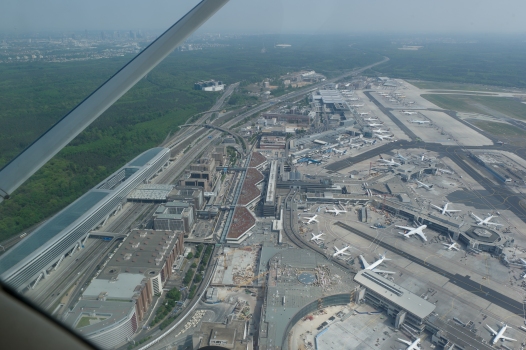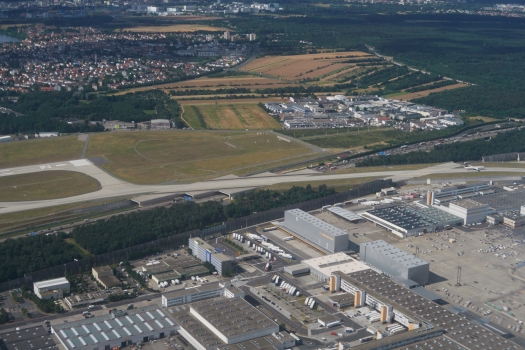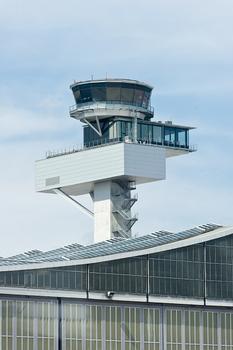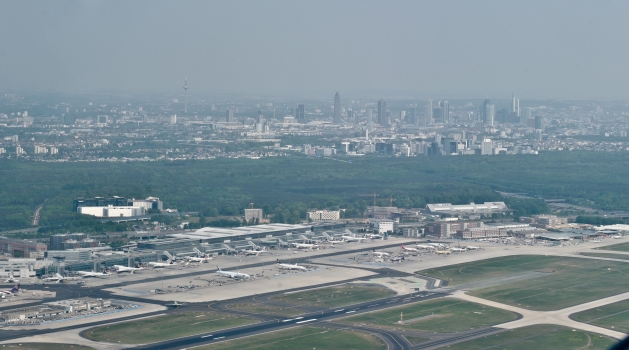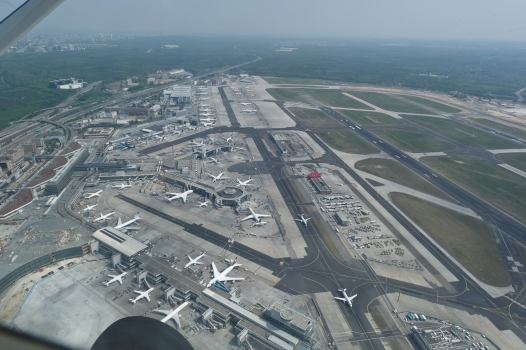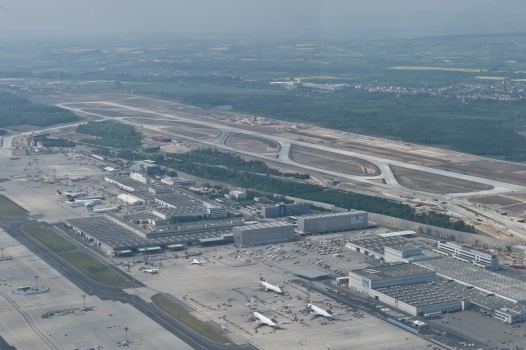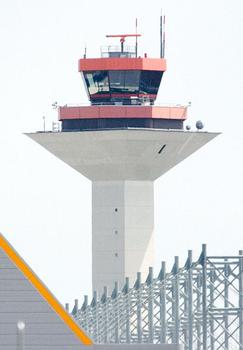General Information
| Name in local language: | Flughafen Frankfurt am Main |
|---|---|
| Completion: | 8 July 1936 |
| Status: | in use |
Project Type
| Function / usage: |
Airport |
|---|
Location
| km | Name |
Technical Information
Dimensions
| runway 07C/25C | width | 60 m |
| length | 4000 m | |
| runway 07L/25R | width | 45 m |
| length | 2800 m | |
| runway 07R/25L | width | 45 m |
| length | 4000 m | |
| runway 18 | width | 45 m |
| length | 4000 m |
Excerpt from Wikipedia
Frankfurt am Main Airport (IATA: FRA, ICAO: EDDF) (German:Flughafen Frankfurt am Main [ˈfluːkhaːfn̩ ˌfʁaŋkfʊɐ̯t ʔam ˈmaɪn], also known as Rhein-Main-Flughafen) is a major international airport located in Frankfurt, the fifth-largest city of Germany and one of the world's leading financial centres. It is operated by Fraport and serves as the main hub for Lufthansa including Lufthansa CityLine and Lufthansa Cargo as well as Condor and AeroLogic. The airport covers an area of 2,300 hectares (5,683 acres) of land and features two passenger terminals with a capacity of approximately 65 million passengers per year, four runways and extensive logistics and maintenance facilities.
Frankfurt Airport is the busiest airport by passenger traffic in Germany as well as the 4th busiest in Europe after London Heathrow Airport, Paris–Charles de Gaulle Airport and Amsterdam Airport Schiphol. The airport is also the 13th busiest worldwide by total number of passengers in 2016, with 60.786 million passengers using the airport in 2016. In 2017 Frankfurt Airport handled 64.500 million passengers and in 2018 nearly 70 million. It also had a freight throughput of 2.076 million metric tonnes in 2015 and is the busiest airport in Europe by cargo traffic. As of summer 2017, Frankfurt Airport serves more than 300 destinations in 5 continents, making it the airport with the most direct routes in the world.
The southern side of the airport ground was home to the Rhein-Main Air Base, which was a major air base for the United States from 1947 until 2005, when the air base was closed and the property was acquired by Fraport. In 2017, passengers at the airport increased by 6.1% to 64,500,386 compared to 2016. The airport celebrated its 80th anniversary in July 2016.
Location
Frankfurt Airport lies 12 km (7.5 mi) southwest of central Frankfurt, near the Autobahn intersection Frankfurter Kreuz, where two of the most heavily used motorways in Europe (A3 and A5) meet. The airport grounds, which form a city district of Frankfurt named Frankfurt-Flughafen, are surrounded by the Frankfurt City Forest. The southern portion of the airport grounds extend partially into the cities of Rüsselsheim am Main and Mörfelden-Walldorf, and a western portion of the grounds lie within the city of Kelsterbach.
The airport is centrally located in the Frankfurt/Rhine-Main region, Germany's third-largest metropolitan region, which itself has a central location in the densely populated region of the west-central European megalopolis. Thereby, along with a strong rail and motorway connection, the airport serves as a major transport for the greater region, less than two hours by ground to Cologne, the Ruhr Area, and Stuttgart.
History
The base opened as a German commercial airport in 1936, with the northern part of the base used as a field for fixed-wing aircraft and the extreme southern part near Zeppelinheim serving as a base for rigid airships. That section of Rhein-Main later became the base for the Graf Zeppelin, its sister ship LZ-130, and, until 6 May 1937, for the ill-fated Hindenburg.
The airships were dismantled and their huge hangars demolished on 6 May 1940 during conversion of the base to military use. Luftwaffe engineers subsequently extended the single runway and erected hangars and other facilities for German military aircraft. During World War II the Luftwaffe used the field sporadically as a fighter base and as an experimental station for jet aircraft.
First airport
On 16 November 1909, the world's first airline was founded in Frankfurt am Main: The Deutsche Luftschiffahrts-Aktiengesellschaft (DELAG). DELAG then built the first airport in Frankfurt, called Airship Base at Rebstock, which was located in Bockenheim in the western part of the city and was primarily used for airships in the beginning. It opened in 1912 and was extended after World War I, but in 1924 an expert's report already questioned the possibility of further expansions at this location.
With the foundation of Deutsche Luft Hansa in 1926 a rapid boom of civilian air travel started and soon the airship base became too small to handle the demand. Plans for a new and larger airport located in the Frankfurt City Forest south-west of Schwanheim were approved in 1930, but were not realised due to the Great Depression. After the Machtergreifung in 1933 the government revived the plans and started the construction of the new airport.
Second airport
On the northern part of the airport originated in 1935 a two-storey station building with a six-storey tower, and other operating and outbuildings for maintenance and storage of aircraft. The approximately 100 hectares runway received a grass cover.
The official opening of the new Flug- und Luftschiffhafen Rhein-Main took place on 8 July 1936. The first plane that landed was a Ju 52/3m, Six days later, on 14 July 1936 LZ 127 Graf Zeppelin landed at the airport. 1936 800 tons of cargo and 58,000 passengers were transported, in 1937 70,000 passengers and 966 tons of cargo. In the coming years, the new airport was home base of the two largest German airships LZ 127 Graf Zeppelin and LZ 129 Hindenburg. In 1938 Frankfurt was a central distribution point for the transport of airmail to North America.
On 6 May 1937, it came to a serious accident: The Hindenburg, on the way from Frankfurt to New York, exploded shortly before application in the landing area of Lakehurst, 36 people died. The accident marked the end of the regular air shipping traffic and the end of the era of airships.
World War II
After the beginning of World War II in 1939 all foreign airlines left the airport and control of air traffic was transferred to the Luftwaffe. On 9 May 1940, the first bombers took off to attack France. From August to November 1944 a concentration camp was established in Walldorf, close to the airport site, where Jewish female prisoners were forced to work for the airport. The Allies of World War II destroyed the runway system with airstrikes in 1944 and the Wehrmacht blew up buildings and fuel depots in 1945, shortly before the US Army took control of the airport on 25 March 1945. After the German Instrument of Surrender the war in Europe ended and the US Army started to build a new temporary runway at Frankfurt Airport. The southern part of the airport ground was occupied to build the Rhein-Main Air Base as an Air Force Base for the United States Air Forces in Europe.
Berlin Airlift
In 1948 the Soviet Union blocked the Western Allies' rail and road access to the sectors of West Berlin under Allied control. Their aim was to force the western powers to allow the Soviet zone to start supplying Berlin with food and fuel, thereby giving the Soviets practical control over the entire city. In response, the Western Allies organised the Berlin Airlift to carry supplies via air to the people in West Berlin. The airports in Frankfurt, Hamburg and Hannover were the primary bases for Allied aircraft. The heavy use of these so-called "Raisin Bombers" caused damage to the runway in Frankfurt and forced the US Army to build a second parallel runway. The airlift ended in September 1949 after the Soviet Union ended their blockade.
Growth of the airport
In 1951 restrictions for German air travellers were lifted and civil air traffic started to grow again. In 1952 Frankfurt Airport handled more than 400,000 passengers; a year later it was more than half a million. About 100 to 120 aeroplanes took off from and landed in Frankfurt daily. In 1955, Lufthansa resumed flights to and from Frankfurt and in the same year the Federal Republic of Germany gained its air sovereignty back from the Allies. In 1957 the northern runway was extended, first to 3,000 m (9,843 ft) and then to 3,900 m (12,795 ft), to make it compatible with jet aircraft.
The airport did not emerge as a major international airline hub until 1958 when a new passenger terminal called Empfangsanlage Ost (Terminal East, literally "Arrival Facility East") opened in the north-east corner of the airport site. Only four years later it was clear that the terminal was already too small for the demand. In 1961 Frankfurt already had 2.2 million passengers and 81,000 take-offs and landings, making it the second busiest airport in Europe behind London–Heathrow.
In 1962 it was decided to build an even larger terminal with a capacity of 30 million passengers per year. Work on this terminal began in 1965. The southern runway was extended to 3,750 m (12,303 ft) in 1964. In 1970 a new hangar was inaugurated; this accommodated six jet aircraft and was the world's largest hangar at the time.
The new main terminal
The new terminal, called Terminal Mitte (Central Terminal, today known as Terminal 1) is divided into three concourses (A, B and C) with 56 gates and an electric baggage handling system. Everything opened to the public on 14 March 1972. It was assumed that the terminal capacity would be sufficient for the next 30 years. Along with the new terminal a railway station (Frankfurt Airport station) was opened, the first airport railway station in the Federal Republic of Germany. A few days later the old Empfangsanlage Ost was closed.
The third runway
Planning for a third runway (called Startbahn 18 West) began in 1973. This project spawned massive protests by residents and environmentalists. The main points of conflict were increasing noise and pollution and the cutting down of protected trees in the Frankfurt City Forest. While the protests and related lawsuits were unsuccessful in preventing construction, the Startbahn West protests were one of the major crystallisation points for the German environmental movement of the 1980s. The protests even continued after the runway had been opened in 1984 and in 1987 two police officers were killed by a gunman. This incident ended the Startbahn West protests for good. Because of its orientation in the north–south direction, in contrast to the other east–west runways, the use of the third runway is limited. The Startbahn West can only be used for takeoffs to the south to avoid interference with air traffic on the other runways. Owing to this restriction the runway must be partially or fully closed when northward winds are too strong.
Terminal 2 and the second railway station
In 1990, work on a new terminal (Terminal 2) began because it was anticipated that Terminal Mitte would reach its capacity limit sooner than expected. The new terminal, divided into concourses D and E, was built to the east of the existing terminal where once the Empfangsanlage Ost had been. With its opening in 1994, Frankfurt Airport increased its terminal capacity to 54 million passengers per year. Along with the terminal opening, a people mover system called Sky Line was established to provide a fast connection between Terminal 2 and Terminal Mitte (now renamed Terminal 1).
In 1999 a second railway station, primarily for InterCityExpress long-distance trains (called Frankfurt Airport long-distance station), opened near Terminal 1 as part of the new Cologne–Frankfurt high-speed rail line. At the same time local and regional rail services were based at the existing underground station, now renamed Frankfurt Airport regional station.
Closure of the Rhein-Main Air Base
On 30 December 2005, the Rhein-Main Air Base in the southern part of the airport ground was closed and the US Air Force moved to Ramstein Air Base. The property was handed back to Fraport which allows the airport to use it to build a new passenger terminal. The property of the housing area for the soldiers, called Gateway Gardens, which was located north-east of the airport site, was given back to the city of Frankfurt in the same year and will be developed as a business district in the following years.
The Airbus A380 and The Squaire
From 2005 to 2007 a large Airbus A380 maintenance facility was built at Frankfurt Airport because Lufthansa wanted to station their future A380 aircraft fleet there. Due to economic constraints only half of the facility has been built so far. Both terminals also underwent major renovations in order to handle the A380, including the installation of a third boarding bridge at several gates. Lufthansa's first Airbus A380 went into operation in June 2010 and was named Frankfurt am Main.
In 2011 a large office building called The Squaire (a portmanteau of square and air) opened at Frankfurt Airport. It was built on top of the Airport long-distance station and is considered the largest office building in Germany with 140,000 m² (1,500,000 sq ft) floor area. Main tenants are KPMG and two Hilton Hotels.
Since 2012 the people mover "The Squaire Metro" connects the Squaire with the nine-storey parking structure. On a length of about 300 metres the so-called MiniMetro system with its two cabins can carry up to 1,300 passengers per hour. The constructor of the system was the Italian manufacturer Leitner.
The fourth runway
Plans to build a fourth runway at Frankfurt Airport were underway in 1997, but owing to violent conflicts with the concept Fraport let residents' groups and environmentalists participate in the process to find a mutually acceptable solution. In 2000, a task force presented their conclusion which generally approved a new runway, but of shorter length (only 2.8 kilometres compared to the other three 4-kilometre-long runways), which would serve as a landing-only runway for smaller aircraft. Additional requirements included improved noise protection arrangements and a strict ban on night flights between 11 pm and 5 am across the whole airport. In 2001, Fraport applied for approval to build the new runway, with three possible options. The conclusion was that a runway north-west of the airport site would have the least impact on local residents and the surrounding environment. The plans were approved by the Hessian government in December 2007, but the requested ban on night flights was lifted because it was argued that an international airport like Frankfurt would need night flights, especially for worldwide freight transport. Construction of the new 2,800 m (9,186 ft) long Runway Northwest in the Kelsterbach Forest began in early 2009.
Developments since 2011
The new runway officially went into operation on 20 October 2011, with an aircraft carrying Chancellor Angela Merkel, performing the first landing on 21 October. The centre line separation from the existing north runway is about 1,400 m (4,593 ft). This allows simultaneous instrument landing system (ILS) operations on these two runways, which has not been possible on the other parallel runways, which do not meet the 3,500-foot minimum separation for ILS operations. This allowed the airport to increase its capacity from 83 to 126 aircraft movements per hour.
On 11 October 2011, the Hessian Administration Court ruled that night flights between 11pm and 5am (the so-called Mediationsnacht) are no longer allowed at Frankfurt Airport after the inauguration of the new runway, and therefore overrode the approval from the Hessian government from 2007 which allowed 17 scheduled flights per night. On 4 April 2012 the German Administrative Court confirmed the decision of the Hessian Administration Court, banning night flights between 11pm and 5am.
To handle the predicted passenger amount of about 90 million in 2020, a new terminal section adjacent to Terminal 1 for an additional six million passengers opened on 10 October 2012. It is called Flugsteig A-Plus and exclusively used by Lufthansa mainly for their long-haul flights. Flugsteig A-Plus features eight parking positions and is able to handle four Airbus A380 or seven Boeing 747 at once.
In November 2016, Ryanair announced the opening of a new base at Frankfurt Airport with four routes to Spain and Portugal. This sparked severe criticism, especially from Lufthansa, as Ryanair was granted high discounts and incentives regarding the airport's fees. On 28 February 2017 Ryanair announced its winter programme for Frankfurt which will see a further 20 new routes being added.
Facilities
Terminals
Frankfurt Airport has two large main passenger terminals (1 and 2) and a much smaller dedicated First Class Terminal which is operated and exclusively used by Lufthansa. As is the case at London Heathrow Airport, Los Angeles International Airport (bar the Tom Bradley International Terminal), and O'Hare International Airport's future Global Terminal, terminal operations are grouped for airlines and airline alliances rather than into domestic and international routes.
Terminal 1
Terminal 1 is the older and larger one of the two passenger terminals. The landside is 420 metres long. It has been enlarged several times and is divided into concourses A, B, C and Z and has a capacity of approximately 50 million passengers per year. Terminal 1 is functionally divided into three levels, the departures level on the upper floor with check-in counters, the arrivals level with baggage claim areas on the ground floor and, underneath, a distribution floor with access to the regional station and underground and multilevel parking. Departures and arrivals levels each have separate street approaches. A bus station is located at arrivals level. Terminal 1 has a total of 103 gates, which include 54 gates equipped with jetways (25 in Concourse A, 18 in Concourse B, 11 in Concourse C). Concourse Z sits on top of Concourse A sharing the same jet bridges between both concourses. Flights to non-Schengen destinations depart from the Z gates and Schengen flights depart from the A gates.
Pier A was extended by 500 metres in 2000, and a link between Terminal 1 and Terminal 2, as well as the Hall C extension opened in 2008.
On 10 October 2012, an 800-metre-long westward expansion of Terminal 1 called Pier A-Plus went into operation. It provides more stands for wide-body aircraft like the Airbus A380.
Terminal 1 is primarily used by Lufthansa, its associated companies (Brussels Airlines, Eurowings, Swiss International Air Lines, and Austrian Airlines) and its Star Alliance partners (e.g. Aegean Airlines, Air Canada, Air China, Air India, All Nippon Airways, Asiana Airlines, Croatia Airlines, LOT Polish Airlines, Scandinavian Airlines, Singapore Airlines, South African Airways, TAP Air Portugal, Thai Airways, Turkish Airlines and United Airlines).
Some airlines that are not part of the Lufthansa Group or Star Alliance also use Terminal 1. They include Air Malta, Bulgaria Air, Iran Air, Oman Air, and Tunisair among others.
Terminal 2
Terminal 2, which has a capacity of 15 million passengers a year, was opened in 1994 and is divided into concourses D and E. A continuous concourse between Terminal 1C and 2D provides direct, but non-public access between the two terminals. It has eight gates with jetways and 34 apron stands, a total of 42 gates and is able to handle wide-body aircraft such as the Airbus A380.
Terminal 2 is primarily used by airlines of the oneworld (e.g. American Airlines, British Airways, Cathay Pacific, Finnair, Iberia, Japan Airlines, LATAM Airlines, Malaysia Airlines, Royal Jordanian and S7 Airlines) and SkyTeam alliances (e.g. Aeroflot, Air France, China Airlines, China Eastern Airlines, China Southern Airlines, Czech Airlines, Delta Air Lines, KLM, Korean Air, Saudia, TAROM and Vietnam Airlines; note that SkyTeam members Alitalia and Middle East Airlines operate out of Terminal 1, in concourses B and C).
Terminal 2 is also used by airlines that do not belong to any of the three major airline alliances, including Air Moldova, Air Serbia, Kuwait Airways, Royal Air Maroc, and Somon Air, among others.
Terminal overview
Terminal Concourse Schengen gates Non-Schengen gates Location 1 1A A1-A69 Terminal 1, western concourse, lower departure level 1Z Z11-Z69 Terminal 1, western concourse, upper departure level 1B B1-B19 (inner area) B20-B63 (outer area) Terminal 1, central concourse 1C C1 C2-C20 Terminal 1, eastern concourse 2 2D D21-D44 (lower departure level) D1-D20/D50-D54 (upper departure level) Terminal 2, western concourse 2E E21-E26 (lower departure level) E2-E13 (upper departure level) Terminal 2, eastern concourse
Lufthansa First Class Terminal
Lufthansa operates a small dedicated First Class Terminal near Terminal 1 with exclusive access for Lufthansa first class passengers and HON Circle frequent flyer members only. Other first class passengers must use the dedicated first class lounges within the main terminals. The facility has 200 staff and is used by about 300 passengers daily. It provides individualised security screening and customs facilities. Amenities include valet parking, a white-linen restaurant, lounge and office areas, a cigar room and bubble baths. Passengers are transported directly from the terminal to the plane by luxury car.
SkyLine
Passengers and visitors can change terminals with the people mover system SkyLine which has the following stops:
The travel time between the terminals is 2 minutes with trains arriving every 2–3 minutes during the day. Additionally there is regular bus service between the terminals.
Runways
Frankfurt Airport has four runways of which three are arranged parallel in east–west direction and one in north–south direction. In 2010 three runways (Runways North, South and West) handled 464,432 aircraft movements, which equated to 83 movements per hour. With the start of operation of the Northwest Runway in October 2011 the airport was predicted to be able to handle 126 movements per hour. It is predicted that aircraft movements will increase up to 700,000 in the year 2020. By using the fourth runway, Frankfurt Airport is able for the first time to handle simultaneous parallel landings, because the distance between the north and the north-west runways is 1,400 m (4,593 ft). Simultaneous parallel landings were not possible with the north and south runway pairing, because the separation distance did not meet the safety standards.
During normal operation the two outer parallel runways (07L/25R and 07R/25L) are used for landings and the central parallel runway (07C/25C) and the Runway West (18) for take-offs. The three parallel runways have two markings because they can be operated in two directions while the Runway West can only be used in one direction.
Future expansions
Terminal 3 (under construction)
In 2009, the German government decided to create third terminals for both Frankfurt Airport and Munich Airport in order to handle expected passenger flows of 90 million in Frankfurt by 2020 and 50 million in Munich by 2017. The new terminal is scheduled to be built by Fraport, south of the existing terminals on the grounds of the former Rhein-Main Air Base. The new Terminal 3 is to accommodate up to 25 million passengers and will feature 75 new aircraft positions when completely constructed. An extension of the SkyLine people mover system is planned to connect the new terminal to Terminals 1 and 2 and the airport train stations.
In August 2014, the city of Frankfurt granted building permission for the first phase of Terminal 3. The groundbreaking for the new terminal took place on 5 October 2015. Its first phase, consisting of the main building and two of the planned four piers (concourses 3H and 3J), is planned to open by 2023 and will be able to handle 15 million additional passengers per year. Total costs are estimated at 3 billion euros.
In 2017, Frankfurt Airport indicated that the second-phase construction of the eastern-most pier (concourse 3G) could be moved forward so that low-cost carriers can use this pier from 2021. If approved by municipal authorities, the piers will be constructed and used according to the following timetable:
Concourse 3G (eastern-most pier):
- Construction of first twelve bus gates, reachable via shuttle buses from terminals 1/2, in use by 2021
- Construction of additional twelve bus gates by 2023/2024
- Construction of passenger bridges by 2025/2026
Check-in area, concourses 3H and 3J (central piers): Construction by 2023 including transport systems for visitors, passengers and luggage to the other terminals
- Concourse 3H is planned for Schengen flights
- Concourse 3J is planned for non-Schengen flights
Concourse 3K (western-most pier): Possible third-phase expansion depending on development of passenger numbers
Passenger Transport System
A new passenger transport system is planned for the connection of the new terminal 3 and the existing terminals 1 and 2. It will use a track which is separate from the existing SkyLine people mover but will allow for interchanges between them. It is scheduled to have four stops in the final stage:
Stop Location/remarks F Long- and short-distance railway station 1C Interchange station to SkyLine (long-term planning) 2DE Interchange station to SkyLine (upon inauguration of PTS) 3GHJK
Other facilities
Airport City
The airport ground and the surrounding area of Frankfurt Airport offer a large variety of on-airport businesses as well as airport-related businesses, including office space, hotels, shopping areas, conference rooms and car parks. The development of an airport city has significantly accelerated in recent years.
Frankfurt Airport Centres
The Frankfurt Airport Centre 1 (FAC 1) near Terminal 1 offers office and conference facilities, the newer FAC 2 is located within Terminal 2 and offers office space for airlines.
Airport City Mall
The Airport City Mall is located on the landside of Terminal 1, departure hall B. It offers national and international retailers and label stores, a supermarket and several restaurants.
The Squaire
The Squaire is an office building with a total floor area of 140,000 m² (1,506,900 sq ft). It is directly connected to Terminal 1 through a connecting corridor for pedestrians. The accounting firm KPMG, Lufthansa and two Hilton Hotels (Hilton Garden Inn Frankfurt Airport with 334 rooms and Hilton Frankfurt Airport with 249 rooms) occupy space in The Squaire.
Main Airport Centre
The Main Airport Centre, named after the Main river, is an office building with ten floors and about 51,000 m² (549,000 sq ft) of office space. It is located at the edge of the Frankfurt City Forest near Terminal 2.
Sheraton Hotel & Conference Centre
Sheraton Hotels and Resorts offers 1,008 guest rooms adjacent to Terminal 1 and a conference centre for up to 200 delegates.
Gateway Gardens
Gateway Gardens is a former housing area for the United States Air Force personnel based at the Rhein-Main Air Base, close to Terminal 2. Like the air base, the housing area was closed in 2005. Since then the area is being developed into a business location for airport-related companies. Lufthansa moved its airline catering subsidiary LSG Sky Chefs to Gateway Gardens, Condor and SunExpress are headquartered here. DB Schenker, the logistics company of Deutsche Bahn, have built a 66 m (217 ft) high-rise building.
Deutsche Bahn are also currently in the process of adding a new S-Bahn train station in this area. This includes re-routing of the existing S-Bahn line into new tunnels between the existing Frankfurt Airport Regional Station and Frankfurt-Stadion station. The journey time will increase by 4 minutes but Deutsche Bahn have stated that they will use new trains (ET423) which will be faster and have more capacity.
Text imported from Wikipedia article "Frankfurt Airport" and modified on July 22, 2019 according to the CC-BY-SA 4.0 International license.
Participants
Relevant Web Sites
Relevant Publications
- (1996): Building for Air Travel. Architecture and Design for Commercial Aviation. The Art Institute of Chicago, Prestel, Munich (Germany), pp. 144-145.
- Klimaanlagen im neuen Rhein-Main-Flughafen Frankfurt. In: Schweizerische Bauzeitung (1947-1978), v. 89, n. 5 (4 February 1971).
- (2010): Modernisierung und Erweiterung des Flughafens Frankfurt. Planen und Bauen im Bestand als Herausforderung. In: [ Umrisse ], v. 10, n. 4-5 ( 2010), pp. 18.
- Renovation of the Boeing 747 maintenance hangar. Investigation of the tendons of maintenance hangar V, Frankfurt airport, Germany. In: DSI Info, n. 14 ( 2006- 2007), pp. 31.
- (2015): Untersuchung des Energiehaushaltes des Frankfurter Flughafens mithilfe von Gebäudesimulation für einen Flugsteig und ein Verwaltungsgebäude. In: Bauphysik, v. 37, n. 2 ( 2015), pp. 124-131.
- About this
data sheet - Structure-ID
10000123 - Published on:
22/07/2002 - Last updated on:
06/03/2022

